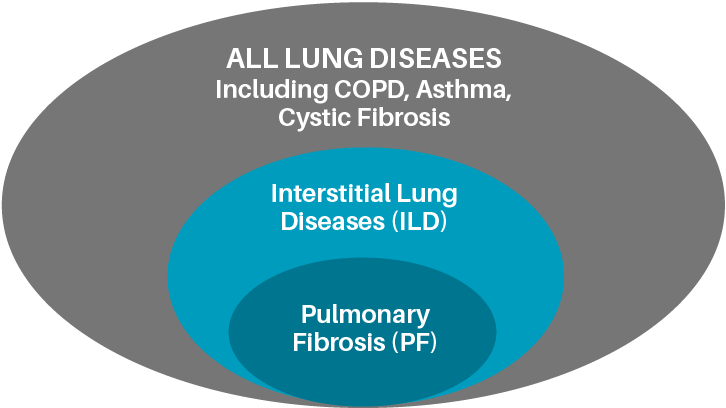PF Basics: Info for Newly Diagnosed Patients

Your essential questions answered
Top takeaways
- Pulmonary fibrosis (PF) is a disease process that causes lung scarring. It’s part of a larger group of diseases, called interstitial lung disease (ILD), that cause inflammation or scarring in the lungs.
- Life expectancy for people with PF varies depending on the specific type of PF, when it was diagnosed, how the person with PF responds to treatment, other health issues the person may have, and more.
- There are many types of PF. Some have known causes, and some have unknown causes or are unclassifiable. Treatments and outcomes can vary depending on the type of PF.
- When two or more close blood relatives have PF, it’s considered familial PF.
- Diagnosis of PF involves recognizing several symptoms common to the disease, then asking questions and performing tests to confirm the diagnosis and identify the specific type of PF, if possible.
Frequently asked questions
People newly diagnosed with PF tend to have the same initial questions, usually focusing on the cause of their disease, their life expectancy, whether their family members may be affected, and how their doctors arrived at the diagnosis. Below, we briefly answer these important questions.
What are pulmonary fibrosis and interstitial lung disease?
Pulmonary fibrosis (PF for short) is a disease process that causes lung scarring. This scarring of the lungs blocks the movement of oxygen into the bloodstream. PF isn’t just one disease. It’s a family of more than 200 different lung diseases that all look similar. The PF family of lung diseases is part of an even larger group of diseases called interstitial lung diseases (also known as ILD). Interstitial lung diseases include all the diseases that cause inflammation and/or scarring in the part of the lungs called the air sacs (alveoli), and the tissue surrounding the air sacs. Some interstitial lung diseases don’t cause lung scarring. When an ILD does include scarring in the lung, we call it pulmonary fibrosis.

I’ve been diagnosed with PF. Is it true that I have 3-5 years to live?
What are the different types of pulmonary fibrosis and interstitial lung disease?
.jpg?sfvrsn=84db5635_0)
Does pulmonary fibrosis run in families?
When two or more closely related blood relatives have PF, it’s considered familial pulmonary fibrosis (FPF). With additional research, we hope to better understand how genetics and other factors—such as smoking or environmental and workplace triggers—may work together to cause multiple members of a particular family to develop PF.
It’s currently estimated that about one in five people with pulmonary fibrosis have FPF. This means that about 80% of people diagnosed with PF won’t have other family members who have the disease—they’ll be the only person in their family who has pulmonary fibrosis. This does not mean that 20% of the individuals in a family affected by FPF will get PF. In some families, there may only be a couple of people diagnosed with PF, while other families have more members diagnosed. It’s not currently well understood why some families have many people diagnosed with PF, others only a few.
In about one-third of families with FPF, variation in genes linked to the development of PF can be identified. Having a genetic variant associated with PF or ILD doesn’t necessarily mean a person will develop one of these diseases. The specific variant involved, how it’s inherited, and how high-risk it is all contribute to how the presence of that variant will affect a family member. Many genes linked to the development of PF have variable or reduced penetrance,” meaning that a person carrying a genetic variant may have the disease in a milder form or never develop it at all.
If it’s suspected you may have familial PF, we encourage you to ask your doctor about talking to a genetic counselor who can help you learn about the risks and benefits of genetic testing.
Read more about familial PF, what we currently know about the genetics of PF, and genetic testing.
What are the tests and processes doctors go through to diagnose PF and ILD?
PF has three characteristics that doctors may use to recognize that someone may have
the disease:
- Stiff, slow-to-stretch lungs affected by scar tissue
- Low blood oxygen
- Lung sounds known as “crackles”
Once a doctor recognizes that a patient may have PF, the next step is to diagnose the specific kind of PF (also see section above). Doctors typically start by taking a complete personal and medical history to identify potential exposures or associated
diseases, performing a careful physical examination, and ordering blood tests. They may also order a special x-ray of the chest, called a high-resolution computed tomography (HRCT) scan, or recommend a lung biopsy. Subtle differences in HRCT scans
may help
detect the type of PF present.
Read more or watch an approximately one hour webinar on the process of diagnosing PF.
.jpg?sfvrsn=175a9c5b_0)
Patient stories
Next steps
Order an information packet or get answers to your questions by calling the PFF Help Center at 1-844-825-5733 or emailing help@pulmonaryfibrosis.org.
